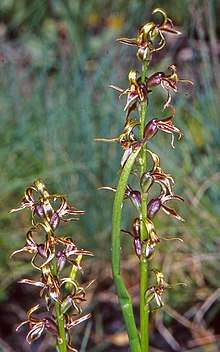Prasophyllum sphacelatum
| Subalpine leek orchid | |
|---|---|
 | |
| Prasophyllum sphacelatum growing in Namadgi National Park | |
| Scientific classification | |
| Kingdom: | Plantae |
| Clade: | Angiosperms |
| Clade: | Monocots |
| Order: | Asparagales |
| Family: | Orchidaceae |
| Subfamily: | Orchidoideae |
| Tribe: | Diurideae |
| Subtribe: | Prasophyllinae |
| Genus: | Prasophyllum |
| Species: | P. sphacelatum |
| Binomial name | |
| Prasophyllum sphacelatum | |
Prasophyllum sphacelatum, commonly known as the subalpine leek orchid, is a species of orchid endemic to south-eastern Australia. It has a single tubular, dull green leaf and up to eighteen scented, green to brownish flowers with a green to pinkish labellum. It grows in subalpine areas of New South Wales, Victoria and Tasmania.
Description
Prasophyllum sphacelatum is a terrestrial, perennial, deciduous, herb with an underground tuber and a single dull green, tube-shaped leaf, 280–380 mm (11–15 in) long and 2–4 mm (0.08–0.2 in) wide with a white to reddish base. The free part of the leaf is 80–140 mm (3–6 in) long. Between six and eighteen flowers are arranged along a flowering spike about 80–140 mm (3–6 in) long. The flowers are green to reddish-brown, 14–18 mm (0.6–0.7 in) long and strongly scented. As with others in the genus, the flowers are inverted so that the labellum is above the column rather than below it. The dorsal sepal is egg-shaped to lance-shaped, 6–8 mm (0.2–0.3 in) long and 3–4 mm (0.1–0.2 in) wide. The lateral sepals are 7–8 mm (0.28–0.31 in) long, about 1.5 mm (0.06 in) wide and the petals are linear, to narrow lance-shaped, about 7 mm (0.3 in) long and 1 mm (0.04 in) wide. The labellum is green to pinkish, egg-shaped to lance-shaped, 6–8 mm (0.2–0.3 in) long, about 3 mm (0.1 in) wide and turns sharply upwards with wavy edges. Flowering occurs from December to February.[2][3]
Taxonomy and naming
Prasophyllum sphacelatum was first formally described in 1996 by David Jones from a specimen collected near Tantangara Dam in the Kosciuszko National Park and the description was published in Muelleria.[1][3] The specific epithet (sphacelatum) is an Ancient Greek word meaning "gangrene", "mortification" or "necrosis"[4] referring to the observation that the leaf tip is withered at flowering time.[3]
Distribution and habitat
The subalpine leek orchid grows in subalpine herbfield and grassland, sometimes with grasses and shrubs in snow gum (Eucalyptus pauciflora) forest. It is found in sulalpine regions of New South Wales south from the Brindabella Range, in north-eastern Victoria and in Tasmania where it often grows on buttongrass plains.[2][3][5]
References
- 1 2 "Prasophyllum sphacelatum". APNI. Retrieved 16 October 2017.
- 1 2 Weston, Peter. "Prasophyllum sphacelatum". Royal Botanic Garden Sydney - plantnet. Retrieved 16 October 2017.
- 1 2 3 4 Jones, David L. (1996). "Resolution of the Prasophyllum alpinum R.Br. (Orchidaceae) complex in mainland south-eastern Australia, Tasmania and New Zealand" (PDF). Muelleria. 9: 59–62. Retrieved 16 October 2017.
- ↑ Brown, Roland Wilbur (1956). The Composition of Scientific Words. Washington, D.C.: Smithsonian Institution Press. p. 668.
- ↑ Jones, David L. (1998). "Contributions to Tasmanian Orchidology". Australian Orchid Research. 3 (6): 114–115.
External links

